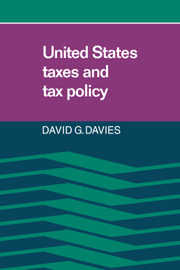Book contents
- Frontmatter
- Contents
- Preface
- 1 Economic foundations of U.S. tax policy
- 2 The individual income tax
- 3 Economic effects of individual income taxes and inflation
- 4 Expenditure versus income taxation
- 5 The taxation of capital gains
- 6 The corporation income tax
- 7 The corporation income tax and inflation
- 8 Social security payroll taxes
- 9 The value added tax
- 10 The sales tax
- 11 State taxes
- 12 Local government taxes
- 13 The distribution of tax burdens
- 14 Status of U.S. taxes and policy
- Appendix
- References
- Index
13 - The distribution of tax burdens
Published online by Cambridge University Press: 05 May 2010
- Frontmatter
- Contents
- Preface
- 1 Economic foundations of U.S. tax policy
- 2 The individual income tax
- 3 Economic effects of individual income taxes and inflation
- 4 Expenditure versus income taxation
- 5 The taxation of capital gains
- 6 The corporation income tax
- 7 The corporation income tax and inflation
- 8 Social security payroll taxes
- 9 The value added tax
- 10 The sales tax
- 11 State taxes
- 12 Local government taxes
- 13 The distribution of tax burdens
- 14 Status of U.S. taxes and policy
- Appendix
- References
- Index
Summary
Incidence studies seek to determine who actually pays how much in taxes (Break 1974:119–237). Two objects of research on incidence are to determine whether the tax structure of a country has had an effect on the distribution of income and to ascertain if the tax structure is equitable as perceived by the majority of voters. To help find the answers to these questions, researchers study the vertical equity of taxes. Unlike the rule of horizontal equity, which implies that individuals in like economic circumstances should be taxed similarly, vertical equity is concerned with the distribution of taxes between and among different income classes.
Most governments, societies, and countries either explicitly or implicitly use individual or household income as a measure of the economic well-being of the taxpaying unit. Vertical equity in taxation is concerned with the relationship between taxes paid and the income of the taxpayer. Even though a rich individual's tax bill is larger than that of a less wealthy person, if the tax as a proportion of income is lower than that of the person with a smaller income, the levy is characterized as a regressive tax. If the ratio of taxation is constant for all individuals, regardless of the level of income, it is proportional tax. Finally, if the share of income a person pays in taxes increases as income increases, it is a progressive tax.
- Type
- Chapter
- Information
- United States Taxes and Tax Policy , pp. 272 - 284Publisher: Cambridge University PressPrint publication year: 1986



